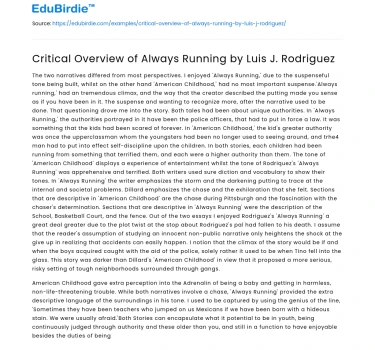Introduction
Luis J. Rodriguez's "Always Running: La Vida Loca, Gang Days in L.A." is a poignant memoir that delves into the gritty realities of gang life and the socio-economic challenges faced by Latino youth in Los Angeles. Published in 1993, the book offers a personal narrative that interweaves themes of poverty, identity, and resilience. Rodriguez's work serves as an unflinching portrayal of his own experiences growing up in a gang-ridden environment during the 1960s and 1970s. This essay provides a critical overview of "Always Running," exploring its thematic elements, narrative structure, and broader societal implications. By examining Rodriguez's narrative through the lens of critical race theory and sociological perspectives, this essay seeks to highlight the enduring relevance of the memoir in understanding contemporary issues of race, identity, and systemic inequality.
Transitioning from an analysis of the memoir's thematic depth, we will consider the narrative strategies employed by Rodriguez. By doing so, we can better appreciate how his personal story resonates with broader societal dynamics. This will involve a detailed examination of Rodriguez's use of language and storytelling. Furthermore, a discussion of counter-arguments will help to underscore the complexities inherent in depicting gang life and its associated struggles.
Save your time!
We can take care of your essay
- Proper editing and formatting
- Free revision, title page, and bibliography
- Flexible prices and money-back guarantee
Thematic Exploration of Identity and Systemic Inequality
"Always Running" is a compelling exploration of identity and systemic inequality, capturing the struggles of marginalized communities in urban America. Rodriguez's narrative is deeply rooted in his Chicano identity, highlighting the cultural dissonance experienced by many Latino youths. This is exemplified in his depiction of the tension between maintaining cultural heritage and assimilating into the dominant American culture. As Rodriguez states, "I was living two lives: the Mexican at home, the American at school." This duality underscores the challenges faced by immigrants and their descendants in navigating a bicultural existence.
The memoir also serves as a critique of systemic inequalities that perpetuate cycles of poverty and violence. Rodriguez vividly describes the socio-economic conditions that contribute to gang involvement, such as inadequate schooling, lack of employment opportunities, and racial discrimination. These factors are not merely background details but are integral to understanding the choices made by individuals living in these environments. As noted by sociologist William Julius Wilson, "Social isolation and economic disadvantage are the root causes of urban poverty." Rodriguez's narrative echoes this sentiment, providing a firsthand account of how systemic barriers limit the life chances of marginalized groups.
However, critics argue that Rodriguez's portrayal of gang life may inadvertently romanticize violence and delinquency. They suggest that the memoir's vivid descriptions might glamorize gang culture to impressionable readers. Yet, Rodriguez counters this by emphasizing the destructive nature of gang involvement and the personal toll it takes. He writes, "There is no glory in this life, only the constant threat of death." This counter-narrative reinforces the memoir's role as a cautionary tale rather than an endorsement of gang affiliation.
Transitioning from thematic analysis to narrative techniques, it is essential to consider how Rodriguez's storytelling style enhances the memoir's impact. His use of vivid imagery and raw honesty draws readers into his world, creating an immersive experience that is both enlightening and unsettling.
Narrative Techniques and Storytelling
Rodriguez employs a range of narrative techniques that contribute to the authenticity and emotional depth of "Always Running." One of the most striking aspects of his storytelling is the use of vivid, often visceral imagery. This technique not only paints a detailed picture of the environments he describes but also evokes strong emotional responses from readers. For instance, Rodriguez's portrayal of violence is unflinchingly graphic, yet it serves a purpose beyond mere shock value. It forces readers to confront the harsh realities faced by those living in gang-dominated communities.
Moreover, Rodriguez's narrative is characterized by a raw honesty that lends credibility to his account. He does not shy away from revealing his own participation in gang activities, nor does he attempt to portray himself as a hero. This candidness allows readers to see Rodriguez as a complex individual shaped by his circumstances, rather than a one-dimensional character. As literary critic Barbara Ransby notes, "Rodriguez's openness about his past mistakes and struggles invites readers to engage with his story on a deeper level."
Despite the effectiveness of Rodriguez's narrative techniques, some critics argue that the memoir's non-linear structure can be disorienting. The frequent shifts in time and perspective may challenge readers' ability to follow the narrative arc. However, this structure mirrors the chaos and unpredictability of the life Rodriguez describes, thus enhancing the memoir's authenticity. By weaving together past and present, Rodriguez creates a tapestry of experiences that underscores the lasting impact of his formative years.
As we transition to the conclusion, it is important to reflect on the broader implications of "Always Running." The memoir not only tells a personal story but also raises critical questions about societal structures and the potential for change.
Conclusion
In conclusion, "Always Running" by Luis J. Rodriguez is a powerful memoir that offers valuable insights into the complexities of identity, systemic inequality, and resilience. Through his candid narrative and evocative storytelling, Rodriguez provides a voice to marginalized communities and challenges readers to confront uncomfortable truths about society. Despite criticisms regarding the portrayal of violence and the memoir's structural complexity, "Always Running" remains an essential read for those seeking to understand the interplay between individual experiences and broader societal forces.
Ultimately, Rodriguez's work serves as both a cautionary tale and a call to action. It underscores the need for systemic change to address the root causes of poverty and violence, while also highlighting the potential for personal transformation and redemption. As we reflect on the enduring relevance of "Always Running," it is clear that Rodriguez's narrative continues to resonate with readers, inspiring dialogue and fostering a deeper understanding of the challenges faced by marginalized communities.






 Stuck on your essay?
Stuck on your essay?

